When to Move Milk Behind Food with Nicole Boehm
- The current feeding schedule for baby Raelynn who is breastfeeding, bottle feeding and baby-led weaning.
- How to start your baby on an open cup when beginning to shift milk feeds until after solid foods.
- Ways to gradually limit milk to an appropriate amount as your baby gets older, to help prepare for an easier transition to cow's milk as their one year mark approaches.
- Two of the biggest Indicators that help determine how much milk a baby should be drinking.

LISTEN TO THIS EPISODE
Episode Description
How can I switch my baby's feeding schedule so they eat solids before offering milk? Will my baby need to drink less bottles when eating more food? As a baby nears the one year mark, it is important to prepare them for the transition into cow's milk by switching solids before milk feeds but also gradually reducing the amount of milk that they drink.

About the Guest
- Nicole Boehm is a first time mom doing baby-led weaning and has offered over sixty different foods from my 100 First Foods list with her baby Raelynn who is approaching her one year birthday.
- She has a fluctuating schedule which allows dad and grandma to help with her baby’s feeding schedules.
- Nicole breastfeeds and offers milk in bottles to her baby but is now ready to shift her milk feeds behind her solid food meals.

Links from this Episode
- Shop ezpz’s tiny cup and mini cup + straw system for baby-led weaning. They’re all 100% foodgrade silicone and designed by ezpz’s feeding expert. Visit ezpzfun.com to use my affiliate code BABYLED for 15% off.
- My affiliate code BABYLED can actually be used for all feeding gear at ezpzfun.com to get that 15% off.
- Baby-Led Weaning with Katie Ferraro program with the 100 First Foods™ Daily Meal Plan, join here: https://babyledweaning.co/program
- Baby-Led Weaning for Beginners free online workshop with 100 First Foods™ list to all attendees, register here: https://babyledweaning.co/baby-led-weaning-for-beginners
Other Episodes Related to this Topic
- Episode 55 - "How to Drop a Milk Feed"
- Episode 101 - "Straw Cup vs. Open Cups: Which Comes First? with Dawn Winkelmann, MS, CCC-SLP"

Latest Episodes
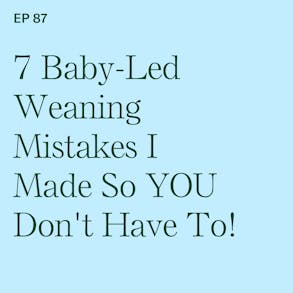
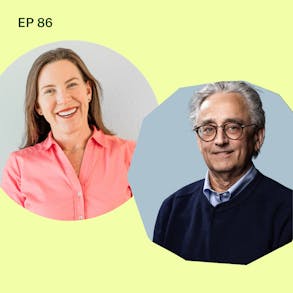
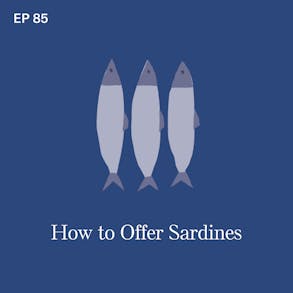
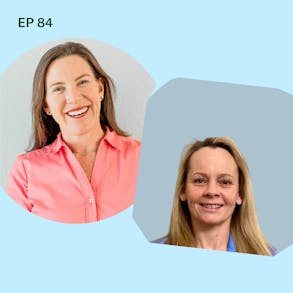
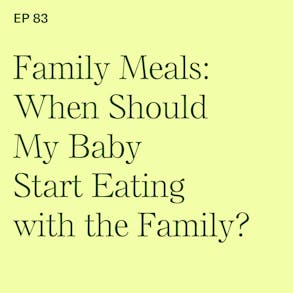

Nicole Boehm (1s):
We kind of just followed her cues. She kind of started to take less milk during feedings and kind of push the bottle away and stuff like that. So we decided we wanted to kind of just try to reduce just a little bit at a time. And so it is less.
Katie Ferraro (14s):
Hey, there I'm Katie Ferraro, registered dietitian, college nutrition professor and mom of seven specializing in baby led weaning here on the Baby-Led Weaning Made Easy Podcast. I help you strip out all of the noise and nonsense about feeding, leaving you with the competence and knowledge. You need to give your baby a safe start to solid foods using baby led weaning. Hey guys. Welcome back today. I'm chatting with a mom named Nicole Boehm. Who's a student in my baby led weaning program called this self feeding baby. Now Nicole is a first-time mom. She's the mom of Raelynn. Who's nine and a half months old. She lives in Rochester, Minnesota.
Katie Ferraro (54s):
You can tell it from her accent, but she's lovely. And the reason why she's on the podcast is because she reached out and said, Katie, I need some help getting Raelynn's milk after her food. So the point of the episode today is I know you guys love schedule stuff is to talk you through what Raelynn's current feeding schedule is at nine and a half months old, and then brainstorm together to help her move. Baby Raelynn's milk after the food. And we'll talk about why it's important to start doing that as you kind of inch towards the one year. Mark Raelynn has tried 60 different foods with baby led weaning using my hundred first foods list. If you guys also want to grab a copy of the a hundred first foods list and learn more about my signature baby led weaning program called the self feeding baby, I teach a free baby led weaning workshop every week.
Katie Ferraro (1m 40s):
It's called baby led weaning for beginners. It's all about how to get your baby to try 100 foods before turning one, without you having to spoonfeed purees or buy pouches. And everyone on that free training gets a copy of the hundred first foods list. So you can start pushing your baby's palate to try this wide variety of foods like Nicole is doing. And occasionally you hit some bumps in the road and that's why I'm there to help you guys get unstuck. So I hope you guys enjoyed this interview. It's all about when to move milk behind food with Nicole bane.
Nicole Boehm (2m 17s):
Hi.
Katie Ferraro (2m 18s):
All right. I am so excited to chat about Raelynn's schedule. Give us a little background. How old is your baby? How's everything been going? How's baby led weaning. And what are we talking about today?
Nicole Boehm (2m 29s):
She will be 10 months here in a couple of weeks. We started baby led weaning, right when she turns six months and it's been going really well. She took the food right away and really enjoyed it. I think her first food, we ended up doing banana, you know, kind of typical banana avocado, sweet potato when we first started, but she's done a lot of meats and a lot of other variety of foods too. I think we're up to like 60 foods now, but otherwise, yeah, it's been going really great.
Katie Ferraro (2m 53s):
Congratulations. So I know when you reached out originally, you were asking about wanting to talk about shifting milk to after meal time. Because as I know you've been studying in my program, like as you get closer to the one year, mark, our goal is to get baby in a position where she's getting more of her nutrition from food then from infant milk. So tell me real quick, what her milk situation it has been. She exclusively breastfeeds. Have you done formula pumping? What's your situation?
Nicole Boehm (3m 19s):
So we typically, or I will typically breastfeed her in the morning, just depending on my work schedule. If I have to be at work super early, then she gets a bottle of breast milk and then, you know, I'll pump throughout the day at work. So probably I would say mostly pumped breast milk bottles. So when she kind of wakes up, we give her a bottle, wait about an hour. Does breakfast usually? Cause we use grandma daycare. So the grandma's totally on board with everything. So she will feed her breakfast, you know, nap, wake up from nap, do a bottle, wait about an hour or so for lunch, some more playtime than another nap. And then again, a bottle then we do dinner and then a little bit of a bedtime bottle before she goes down for the night.
Katie Ferraro (4m 0s):
All right. And if you had to add up the bottles about how many ounces of breast milk is she getting a day on the days where you're not nursing and you can kind of eyeball it from bottles.
Nicole Boehm (4m 10s):
She probably get somewhere, I don't know, right around 18, maybe it's changes
Katie Ferraro (4m 16s):
Wait, which has three, four ounce bottles and then two and a half ounces at bedtime. Was that correct?
Nicole Boehm (4m 20s):
Yeah, probably closer to three and a half to four at bedtime, somewhere in between there
Katie Ferraro (4m 25s):
Somewhere between 15 and 18 ounces a day on top of the food that she's eating now, have you already reduced that? Like when at six and seven months of age, when you just got started, we generally recommend don't make any changes to the milk schedule because of course, Raelynn doesn't know how to get nutrition from food if she doesn't know how to eat yet. So now she's at a point she's had 60 different foods. She starting to pick up on the feeding. Generally families will drop a milk feed. Is that volume 15 to 18 ounces at nine and a half months? Is that less than what she had at let's say six months?
Nicole Boehm (4m 54s):
Yes. So it's probably, I don't know, somewhere between two to four less, we kind of just followed her cues. She kind of started to take less milk during feedings and kind of push the bottle away and stuff like that. So we decided we wanted to kind of just try to reduce just a little bit at a time. And so it is less
Katie Ferraro (5m 12s):
And I hate even asking about the numbers too, because it gives, especially for breastfeeding moms, they get panicked like, well, I don't know exactly how many ounces and it doesn't matter, you know, your baby best. If she staying on her growth curve, like she supposed to at your different well checks, then you're doing a great job, Nicole, how has Raelynn's growth charting then as far as when you go to the pediatrician.
Nicole Boehm (5m 33s):
So we just went for, I believe at nine months and she is on her curve on all aspects, height, weight, and head circumference. So she is on the curb.
Katie Ferraro (5m 42s):
And just out of curiosity, what does your doctor think about baby led weaning? You can be honest if they hate it.
Nicole Boehm (5m 46s):
So they didn't really kind of say, I kind of had to explain it a little bit more. I feel like they're kind of still getting more accustomed to what baby led weaning is, but she didn't tell me not to do it or anything like that.
Katie Ferraro (5m 59s):
Okay. Now, so let's talk about the milk schedule right now, because what you're wanting to do is exactly what we should do somewhere around the nine and a half 10 month. Mark is getting a position where milk starts coming after food. So when you start baby-led weaning two and a half months ago, it's bottles in infant milk, be that breast milk or formula. That's the most important thing because that's where the majority of nutrition is coming from. But now as you know, we're halfway through the latter part of infancy and that period between six and 12 months is a practice period to learn how to eat. But now that she's getting good at eating, let's get her position for the next step, which is by one year of age, baby should be getting more of her nutrition from food than from milk. And one thing we have to look out for is milk, be an infant milk until 12 months.
Katie Ferraro (6m 41s):
And then when you make the switch to cows milk after 12 months, collectively milk is a good thing, but too much of a good thing is not a good thing. And one of the biggest saboteurs of the toddler diet, just looking ahead is certainly milk. And I mentioned that a lot on the podcast, milk and snacks are the two things that kind of sabotage your child diet from 12 months on. So we need to look at the volume of milk and make sure that we're aiming towards when you get that transition at 12 months to cows milk, somewhere between 16 to 24 ounces of cow's milk. And you're already in a fantastic position because you're between 15 and 18 ounces of breast milk. And I wanted to ask, how long do you want to breast feed for or continue to pump for Raelynn?
Nicole Boehm (7m 18s):
My goal is about a year.
Katie Ferraro (7m 20s):
Okay. So you want to be kind of done ish somewhere around or when your birthday? Yep. All right. So the goal now is to start putting the milk behind the food. So my first tip for you is that it's okay. When Raelynn wakes up in the morning to not do that first milk feed, I think you said, was it around six or 7:00 AM where she generally gets a bottle?
Nicole Boehm (7m 38s):
Yup. Yup. She kind of, it varies when she wakes up, but yes.
Katie Ferraro (7m 41s):
Okay. So my first suggestion would be at nine and a half months. It's perfectly fine for you to wake her up, change her, bring her right to the table. No bottle. So the first, which would be dropped that morning bottle, you're not dropping it entirely. We're just going to move that volume of milk to behind breakfast. So wake up morning, routine breakfast right away. And then after breakfast bring in that four ounce bottle, but also start practicing out of the open cup if you can, as well. And it was curious, how is it going? Have you guys tried any open cup practice? Is she into it as she's still learning?
Nicole Boehm (8m 13s):
Yeah. So we do have the ezpz I believe it's is it the tiny one that you..
Katie Ferraro (8m 17s):
A tiny cup is the one that's for babies, six to 12 months of age.
Nicole Boehm (8m 21s):
Yeah. So we've been using that one. She's pretty much got the hang of it can put both her hands around it, bring it to her mouth and kind of tip it back. Sometimes it dribbles down the front a little bit, but otherwise she's got the hang of it. We've kind of tried to do the straw cup as well, but she's not quite there yet. As far as understanding how the straw works.
Katie Ferraro (8m 37s):
So Dawn Winkelman, who's the speech language pathologist who creates the products for ezpz. She designed that tiny cup, like I mentioned, for six to 12 month olds, but you're doing it in the right order. You actually want that open cup practice to come before the straw cups. So it's fine to play around with a straw cup, but really put your emphasis on the open cup. And if this is new to you guys, go back and listen to episode 101, it's called "Straw Cup versus Open Cup, which comes first?" And that's an interview that I did with Dawn. If you guys are interested in checking out those easy peasy products, I am an affiliate for them. And my discount code is KATIE10. So you can get 10% off everything at ezpz. But I think it's great, Nicole, that you guys are trying the open cup and you'll probably notice that volume wise, she's going to drink less out of the cup than the bottle, but that's actually the point because we're moving towards an era where she's going to be getting more nutrition from food and not from milk.
Katie Ferraro (9m 27s):
So I would do six to 7:00 AM where you used to do milk feed, have breakfast. Now some parents roll their eyes when I recommend that, because they're like trying to get out the door. I'm trying to go to daycare. I got to go to work. And so I'm just curious, cause I know you have a kind of a flex schedule, maybe tell us a, what do you do for work and how come your schedule differs a little bit. And do you think you guys would be able to do breakfast first before a bottle in the morning?
Nicole Boehm (9m 48s):
Yeah, so I worked for the local school district here where I live in a school-age childcare program before and after school. My schedule kind of fluctuates one week. I usually work early and then the next week I kind of have a little bit of a later shift. My husband though, however, it has a pretty consistent schedule. So usually if I am on an early week, he's kind of the main guy and kind of handles everything. And then if I have a later week, then I'm kind of the main person in the morning. So we're able to do kind of have that breakfast beforehand. And then we have that option for us available.
Katie Ferraro (10m 20s):
And another thing I recommend to parents of like, that's super stressful, the idea of quote unquote, making breakfast don't make anything new, just make a duplicate plate of whatever the previous meal you had the day before was, or the last meal, put it in the fridge. You get up first, pop it in the microwave or do whatever to get it back to room temperature, slightly warm. Let it cool while you're getting the baby getting her changed, put her right in the high chair. And some parents are like wheat, seriously. It's okay for babies to start with food and not milk once they get the hang of eating, which at 60 foods Raelynn certainly hasn't yeah. Heck yeah. I always drop that morning bottle feed first. And if you guys need some tips on how to drop a milk feed, episode 55 was called how to drop a milk feed and there's more scheduling info in there.
Katie Ferraro (11m 1s):
So Nicole, back to the schedule, I would do breakfast and then the four ounces of breast milk for me to open cup of the bottle. After that, some people want to just practice, like you're already at the table practice with the open cup. She might drink volume wise a little bit less, but that's okay because she's going to get more proficient at the open cup. The less often she's offered the bottle and then I would do play nap. And then the next switch is after that morning nap, instead of doing the bottle, like you guys were do lunch instead. So it might involve talking to your mom because you're very lucky that you get to go to grandma daycare. And just out of curiosity, is your mom on board with baby led weaning? Does she like it? Did she always like it?
Nicole Boehm (11m 35s):
I think when we first talked about it with her, she was a little bit on the fence and it's actually my mother-in-law. Yeah. So she was a little bit on the fence. Cause you know, when she had kids, it was all pureed food. Like that was the main thing that she did. So it took a little bit of, to kind of convince her yet they can have these like strips of food from when we first, you know, at six months do more of the strip type of food. But she, I think once she kinda got the hang of it and kind of felt more comfortable than she was totally on board.
Katie Ferraro (12m 4s):
Okay. So she's on board with this switch after morning nap, maybe an early lunch. So it might be a little bit earlier than she'd eaten before, but when she wakes up, if she's hungry, that's a good thing. Especially if she's moving into 10 months, we want her to be able to experience what I call casual hunger, or we're not starving her out, but she knows how to use food now to help alleviate her hunger feelings. So let's let her practice with that. And then I would do the second that other four ounces of the bottle after the lunch meal and then playing nap afternoon nap. Now the dinner one, I would recommend, you know, dinner as much as you guys can do it. Like I know some families are like, wait a minute. If we're going to have to make dinner earlier, but I'm at work. This could be a shift. Some families will do like a small amount of milk from the open cup. If dinner's not ready just to kind of tighter over and then dinner.
Katie Ferraro (12m 48s):
But I would definitely keep that PM or bedtime bottle because that's again going to help her sleep through the night. And just curious if you remember, how long has she been sleeping through the night and is she still sleeping through the night?
Nicole Boehm (12m 59s):
I would say like consistently sleeping through the night. It's probably been two or three weeks prior to that it was hit her best a couple of times a week where she'd wake up in the middle of the night.
Katie Ferraro (13m 10s):
Different schedules worked for different families and every family has their own thing. But my suggestion for families is like, if you don't have a preference, I always keep that bedtime bottle as the very last one to drop. Cause it really does help with sleep in the evening. And it's a nice bonding experience. You might still be nursing, so it might be milk early dinner milk, but the goal is keep it somewhere around 16 to 24 ounces, which you're already doing as you approach the one year mark. And then you'll have a very easy transition to cow's milk after her first birthday. Okay. Nicole, any other milk, food scheduling questions for Raelynn at the nine and a half month mark.
Nicole Boehm (13m 45s):
So not so much scheduling. However, you know, like as a parent and Google and all that nowadays you have all this influx of information and you can pretty much type in any question and get a thousand different answers. But one of the things like I was looking at, especially with baby-led weaning was the sounds is a milk they should be having per day. And a lot of websites were recommending somewhere between 24 and 30 ounces of milk. And that's just breast milk too, that they were basically from six months to 12.
Katie Ferraro (14m 13s):
Okay. So the caveat there is that all of those estimations are based on the assumption that baby's not eating very much food. And so with baby led weaning, you've seen, Raelynn's tried over 60 different foods. She starting to be more interested in food. You're following her cues by starting to taper off the milk that is weening in action. That's exactly what we want to see. And if you can stay away from the tables with lots of numbers and stuff only because you know your baby best, and you mentioned two things, she's interested in an eating foods and she staying on her growth curve. So those are the two biggest indicators of how much milk she be eating. What happens sometimes it's families see those tables like, oh my gosh, 30 ounces.
Katie Ferraro (14m 55s):
They might've been at 16 or 18. And then all of a sudden they go pumping the baby up with milk because they want to meet whatever some arbitrary table says for six to 12 months, by the way, there's huge developmental range in there. There's no way what your baby drinks at six months should equal what they drink at 12 months or the implication there is you're not trying any foods, which means you're gonna be missing a whole bunch of feeding and nutrition milestone. So the way you're doing it is right by slowly and gradually increasing the amount of food and she's doing it, not you, but you're tapering the milk down, which is allowing her to get to a point where she'll get most of her nutrition from food. So I wouldn't stress about the numbers. I've seen babies that do 12 ounces of formula or 12 ounces of breast milk. If the mom is pumping and measuring and eating food and they're perfectly fine. So just keep an eye on that growth curve.
Katie Ferraro (15m 36s):
You know, keep an eye on her iron levels because what happens too is when parents pop up the milk and kids start to expect a lot of milk, when you transition to cows milk, there's no iron in there. And so then this is full of cows milk all the time, which has no iron, which displaces all of these other nutritious iron containing foods. And then you're with a 12 month old that won't eat food and just wants milk. You should never go up on the milk as you near the one-year mark generally after about eight or nine months of age, that's kind of the peak amount of milk that a baby will and should be drinking because even though they're still growing, as you get closer to that one year, mark, the rate of growth slows down. So you might be surprised like in the next month or two Raelynn actually eats less volume-wise than she's eating right now at nine and a half months, don't go making her drink more milk because her rate of growth is slowing down and we don't want to kind of mess up her ability to recognize and respond to her hunger cues with food, because that's what we want.
Katie Ferraro (16m 28s):
We want her getting nutrition from food and just a smidge from milk. There's also families that drink. Absolutely no cow's milk. As long as baby's meeting their hydration needs from elsewhere, that's perfectly fine as well at it. Well, Nicole, thank you so much for joining me. This was hugely informative. I'm sorry for prying and asking all the questions about your schedule, but I think it helps other parents learn like, you know, there's no one right way or wrong way to do this. And I think you're such a good example of a mom who kind of trust her gut. You're looking at the data, but also knowing that there's differences and there's variations within your own baby, right? Cause one day she might eat great. And the next day she doesn't need it all one day, a lot of milk. One day, not a lot of milk. We're looking at the bigger picture here. Is she growing in the right trajectory? Is she getting exposure to a lot of different foods? Is she learning things like how to drink out of an open cup?
Katie Ferraro (17m 9s):
You guys are hitting all of them. So congratulations to you. Thank you. Well, I hope you guys enjoyed that interview with Nicole Boehm from Rochester, Minnesota, mom of Raelynn. I'll check back in and see how they're doing with that new schedule change for you guys. Maybe we'll edit it and kind of add that onto the end of this podcast in a few weeks and see how did it go to stop doing milk before food and start doing food before milk as your baby is getting older. I'm going to go ahead and link everything we talked about in today's episode, because there was a few other episodes that I mentioned. I'll also put a link for where you can sign up for my free weekly workshop. Baby-led weaning for beginners. If you want some more training about how to give your baby a safe start to solid boots.
Katie Ferraro (17m 50s):
And if you want to grab a copy of my hundred first foods list, I give it away to everyone on that free workshop. I teach it every week. I'll put all those links up for you at blwpodcast.com/235. Thanks so much for listening.
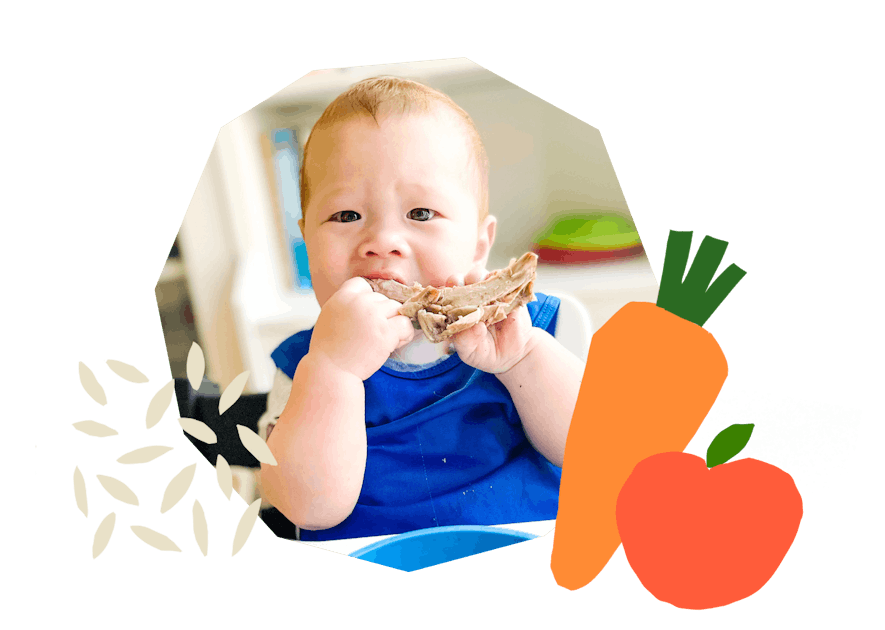
The Program Baby-Led Weaning with Katie Ferraro
A step-by-step digital program for starting solid foods safely and navigating the original 100 FIRST FOODS™ meal plan with baby-led weaning.
 EXPERT-LED, PROVEN APPROACH TO EATING REAL FOOD
EXPERT-LED, PROVEN APPROACH TO EATING REAL FOOD CONCISE VIDEO TRAININGS TO MASTER BABY-LED WEANING
CONCISE VIDEO TRAININGS TO MASTER BABY-LED WEANING 100 FIRST FOODS DAILY MEAL PLAN WITH FOOD PREP VIDEOS
100 FIRST FOODS DAILY MEAL PLAN WITH FOOD PREP VIDEOS
Baby-Led Weaning for Beginners Free Workshop
Is your baby ready to start solid foods, but you’re not sure where to start? Get ready to give your baby a solid foundation to a lifetime of loving real food…even if you’re feeling overwhelmed or confused about this next stage of infant feeding.
Get baby-led weaning recipes and tips delivered to your email inbox.



